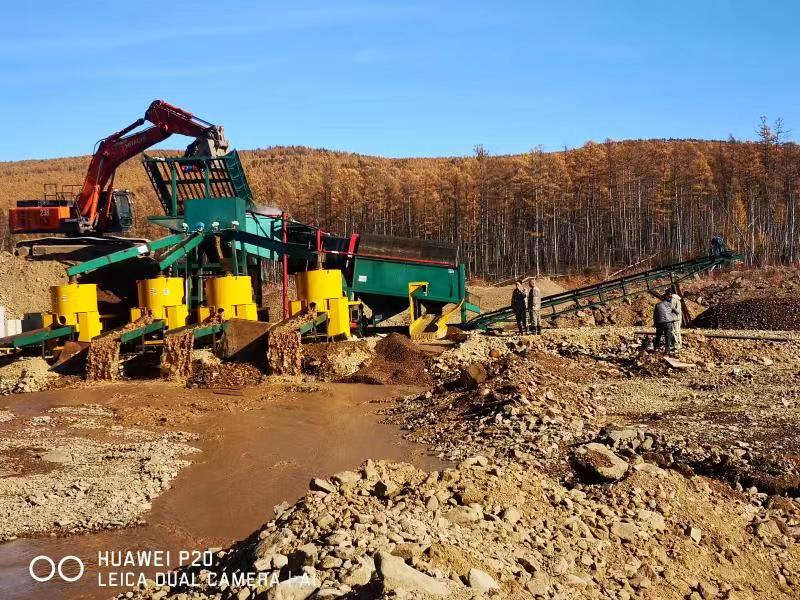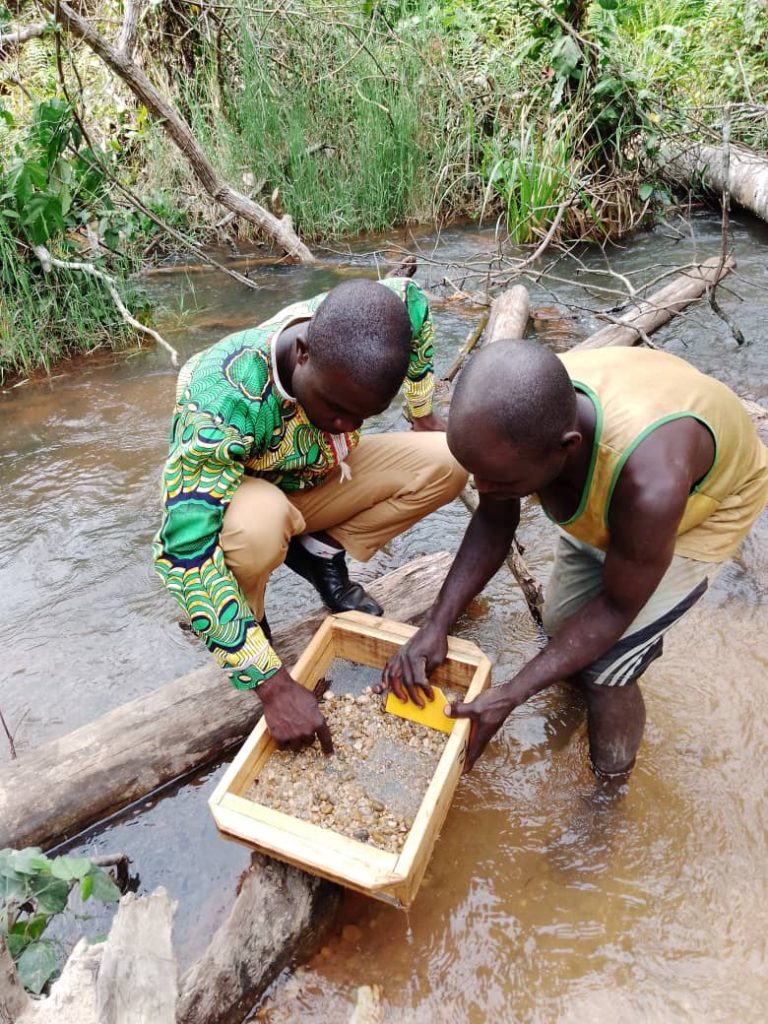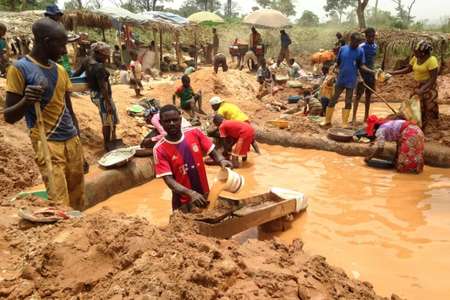Most of the gold mined in California and in rivers across the United States during the height of the gold rush was placer gold. During the 1840s through 1860s gold mining in the United States focused on rivers where miners recovered lose gold nuggets from river beds using simple mining tools such as sluice boxes.
Placers were primarily worked for the first few years until the richest deposits were depleted from the riverbeds. When the richer placers began to play out, miners would venture up into the hills and look for the hard rock sources.
Today placer gold in rivers is very limited compared to what they once were. It would be very difficult for a modern-day recreational miner to understand how placer deposits could cause an unprecedented gold rush like the Californian gold rush in 1848. Today, a hard days of digging on a rich gold-bearing river might produce a gram or two of gold, a far cry from what the old-timers could find.
Placer gold refers to gold found in secondary deposits. Typically, gold is found in lode deposits. However, through the weathering of hard rock and the movement of rivers and glaciers, fine gold nuggets and particles have been transported away from their original lode deposit and deposited elsewhere. These new deposits are usually located near the surface, often along river beds or creeks. The gold discovered in these secondary deposits is known as placer gold.
Placer gold deposits are typically found near lode gold deposits. The gold in hard rock is released through weathering and then transported by glaciers or running water (streams, rivers, floodwater) to a location where it is deposited and concentrated in a placer deposit.
Due to its weight, gold generally does not travel far from its source. Therefore, prospecting rivers and waterways around areas where lode deposits have been discovered can lead to the discovery of gold. Additionally, ancient river channels in regions with gold-bearing rocks and flooding outwash may also contain placer gold.
The most common places to find placer gold are on riverbeds. When a gold-bearing vein becomes exposed due to weathering or other natural forces, the gold remains close to its source. However, during heavy storms that cause rivers and streams to flood, runoff water moves swiftly and carries loose particles of gold into these water bodies.
Occasionally, a river or stream flowing over a gold vein may erode the vein over time and carry loose particles of gold downstream. As gold is heavier than other materials being carried downstream, it exerts downward force on the water and quickly settles on the riverbed once the flow slows down. This creates a rich placer deposit of gold on the riverbed.
Placer gold mining involves extracting minerals from stream bed deposits. This can be done through open-pit mining or using surface excavating equipment or tunneling equipment.
Placer mining is commonly used for precious metals like gold and gemstones, which are often found in alluvial deposits – sand and gravel in modern or ancient stream beds, or sometimes glacial deposits. These metals or gemstones, having been carried by the flow of water from their original source such as a vein, typically make up only a small portion of the total deposit. Because gems and heavy metals like gold are much denser than sand, they tend to accumulate at the bottom of placer deposits.

Placer deposits can range from just a few years old, like the Canadian Queen Charlotte beach gold placer deposits, to billions of years old like the Elliot Lake uranium paleoplacer within the Huronian Supergroup in Canada.
In an alluvial placer mine, the material containing minerals may be too loose to safely extract through tunneling unless the ground is permanently frozen. When there is pressurized water available, it can be used for mining operations such as moving and separating valuable materials from the deposit. This method is known as hydraulic mining, hydraulic sluicing, or hydraulicking.
The word “placer” comes from Spanish “placer,” meaning shoal or alluvial/sand deposit. It derives from “plassa” (place) in Medieval Latin placea (place), which is also related to English words “place” and “plaza.” The Spanish word directly refers to an alluvial or glacial deposit of sand or gravel.
Another possible origin for the English word comes from American Spanish “placer” (sandbank), derived earlier from placel in Portuguese (placer/sandbank).
Placers were a major source of gold during ancient times. Hydraulic mining methods such as hushing were widely employed by Romans across their empire, particularly in the gold fields of northern Spain after its conquest by Augustus in 25 BC. One notable site was Las Médulas, where seven aqueducts spanning 30 miles were used to exploit alluvial gold deposits during the first century AD.
In North America, placer mining gained fame during various gold rushes, including the California Gold Rush, Colorado Gold Rush, Fraser Canyon Gold Rush, and Klondike Gold Rush.
Placer mining continues to be practiced in many parts of the world for diamonds, industrial minerals and metals, gems (in Myanmar and Sri Lanka), platinum, as well as gold (in Yukon, Alaska and British Columbia).
Areas shielded from water flow are ideal locations for finding gold. Due to its high density, gold is often found in stream beds. Different types of gold deposits require different extraction methods. Placer deposits are attractive to prospectors because they have low costs. There are various places where gold can be deposited such as residual deposits, alluvial deposits, and bench deposits.

Residual
Residual deposits are more common in areas where rocks have undergone weathering and there is no water present. These deposits consist of material that has not yet been washed away or moved. Residual deposits typically occur at the site of the original mineral vein and undergo rock weathering.
Alluvial
Alluvial or eluvial deposits are the most common type of placer gold and often contain the highest concentrations. They consist of gold particles that have been carried away from their original source by water and deposited in sediment near or within watercourses, including former ones. As a result, they are primarily found in valleys or flood plains.
Bench deposits form when gold accumulates on a stream bed. High concentrations of gold in old stream beds are referred to as bench deposits. These can be found on higher slopes that drain into valleys. Dry stream beds (benches) may be located far from other sources of water and can sometimes even be found on mountaintops. Many miners nowadays focus their efforts on extracting gold from bench deposits.
Deep leads
Deep leads form when an ancient stream bed becomes covered by later sediments or igneous rock resulting from volcanic activity. Examples of deep leads can be found in the Gulgong and Creswick regions of Australia’s goldfields. The gravel containing gold is accessed through shafts and tunnels similar to those used in underground mining techniques but is typically processed like alluvial gold instead. In some cases, heat associated with volcanic lava flows altered the composition of the gravel containing gold, requiring it to be crushed before extraction; an example of this type was discovered at Forest Reefs, also in Australia.
Methods
Various methods are employed for mining placer gold and gems, both for extracting these minerals from the ground and separating them from non-gold or non-gem materials.
Panning
The simplest technique for extracting placer ore is panning, which dates back to at least the Roman Empire. In panning, a portion of mined ore is placed in a large metal or plastic pan along with an ample amount of water and agitated so that the denser gold particles settle to the bottom while lighter gangue materials such as sand, mud, and gravel are washed over the side of the pan. Once a placer deposit is located through gold panning, miners typically switch to equipment that can process larger volumes of sand and gravel more efficiently. While gold panning was commonly used during the California gold rush, it is now rarely employed for profit due to its limited processing capacity; even experienced prospectors can only process approximately one cubic yard of material every 10 hours of work.
Rocker
A rocker box, also known as a “cradle,” can process more material than a gold pan but is still limited compared to other placer mining methods. It can only handle about 3 or 4 yards of gravel per day. Unlike a sluice box, it is portable and doesn’t require much infrastructure; instead, it is operated by hand. The box sits on rockers that separate the gold when rocked back and forth, hence the term “rocking the golden baby.” A typical rocker box measures approximately 42 inches long, 16 inches wide, and 12 inches deep with a removable tray at the top for placing gold. While widely used during the early gold rush in North America, its popularity declined as more efficient methods capable of handling larger volumes became common.
Sluice box
The same principle can be applied on a larger scale by constructing a short sluice box with riffles along the bottom to trap heavier gold particles while water washes away other materials. This method works best when using shovels or similar tools to feed ore into the device. Sluice boxes can range from just a few feet to over ten feet (commonly referred to as a “Long Tom” if over six feet). Although they can handle larger amounts of material compared to simpler methods like rocker boxes or gold panning, their efficiency may suffer since conventional sluice boxes typically recover only around 40% of processed gold.
During the California gold rush, sluice boxes were extensively used for large-scale operations. As streams became depleted over time, variations such as grizzlies and undercurrents were developed. Grizzlies consist of parallel bars placed at an angle above the main sluice box to filter out larger materials. Undercurrents involve additional auxiliary sluice boxes where initial filtration occurs before passing through troughs into primary sluices for further filtering. Both grizzlies and undercurrents are designed to improve efficiency and were often used in combination.

Dry washing
Sluicing is effective only in areas with sufficient water supply and impractical in arid regions. Alternative methods utilizing air blowing to separate gold from sand were developed. One common dry washing method is the Mexican dry wash, which involves placing gravel on a riffle board with a bellows underneath. The bellows blows air through the board to remove lighter materials while retaining heavier gold. Processing capacity using this technique ranges from 1 1/2 to 4 cubic yards per day, achieving maximum efficiency of 80%. Another form of dry washing is called “winnowing,” commonly employed by Spanish miners in America. It requires only a blanket and a box with a screen at the bottom. Material passes through the box, allowing finer particles onto the blanket. The material on the blanket is then tossed into the air so that any breeze can blow away lighter materials, leaving behind the gold. While this method is simple and requires minimal resources, it is slow and inefficient.
Trommel
A trommel consists of a slightly inclined rotating metal tube with a screen at the end where material is discharged. Lifter bars, often in the form of bolted angle iron, are attached inside the tube. The ore is fed into the higher end of the trommel. Water, usually under pressure, is supplied to both the scrubber and screen sections. The combination of water and mechanical action separates valuable minerals from the ore. The mineral-bearing ore that passes through the screen is further concentrated using smaller devices like sluices and jigs. Larger pieces of ore that do not pass through can be transported to a waste stack by a conveyor.
Gold dredge
Mechanical dredges are used for large-scale sifting of placer gold from extensive alluvial deposits. Originally, these dredges were massive boats capable of processing substantial amounts of material; however, as easily accessible areas have become depleted, smaller and more maneuverable dredges have become more common. These smaller dredges typically operate by pumping water and gravel through long hoses, allowing for separation of gold using traditional methods such as sluice boxes.
Underground mining
In permanently frozen regions like Siberia, Alaska, and Yukon, underground mining may be employed to extract placer deposits since manual excavation on hard frozen ground is impractical. Historically, fires were built to thaw the ground before digging it.[18] Later methods involved blasting jets of steam (“points”) into frozen deposits.
Environmental effects
Although not mandatory, process water can be continuously recycled while extracting sought-after minerals (known as “tailings”) from ore can also be reclaimed. While recycling and reclamation processes are more commonly practiced in modern placer mining operations today they are still not universally implemented.
In earlier times when process water was generally not recycled and spent ore was left unreclaimed after extraction. A Roman alluvial gold mine at Las Médulas remains so remarkable that it has been designated as a UNESCO World Heritage site. The mining methods employed by Roman miners are described in Pliny the Elder’s work Naturalis Historia, published around 77 AD. As a Procurator in the region, he likely witnessed large-scale hydraulic mining of placer deposits and noted that the local lake Carucedo had been heavily silted due to these mining techniques.
Environmental activists consider hydraulic mining in placer mining to be environmentally destructive due to the significant amount of silt it introduces into previously clear streams (referred to as the “Dahlonega Method”). Most modern placer mines use settling ponds, at least to ensure sufficient water for their sluicing operations.
From 1853 to 1884, hydraulicking was extensively practiced in California’s gold fields. This process removed a substantial volume of material from placers, which flowed downstream and raised the level of certain areas in the Central Valley by approximately seven feet. Additionally, thick bars up to 20 feet settled in parts of San Francisco Bay. The opposition group called themselves the “Anti-Debris Association.” In January 1884, the North Bloomfield Mining and Gravel Company case prohibited flushing debris into streams, effectively ending hydraulic mining mania in California’s gold country.
Examples:
The Witwatersrand Basin in South Africa serves as an illustration of a placer deposit. It is a three billion-year-old sedimentary basin containing over 70 ore minerals.
The Klondike Gold Rush began when gold nuggets were discovered in running water within Alaska’s Klondike region and Canada’s Yukon territory back in 1896. This discovery transformed it into an alluvial placer mining deposit, attracting around 30,000 gold-seekers who ventured into the area.
In earlier times, process water was not typically recycled and spent ore was left unreclaimed. The remains of a Roman alluvial gold mine at Las Médulas are so remarkable that they have been designated as a UNESCO World Heritage site. Pliny the Elder describes the methods employed by Roman miners in his work Naturalis Historia published around AD 77. As he served as a Procurator in that region, he likely witnessed large-scale hydraulic mining activities on placer deposits there. He also noted that local Lake Carucedo had become heavily silted due to mining practices.

